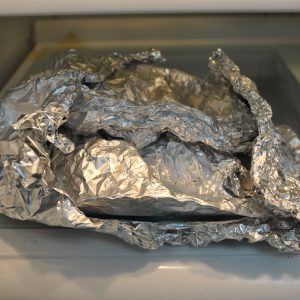
by Samantha Kennedy | Feb 28, 2019

Storing foods in aluminum foil is a not a good food safety practice since it does not form a tight enough seal to keep out air, moisture, or microorganisms. Use air-tight containers or zipper plastic bags to store leftovers safely. (Photo source: Samantha Kennedy)
This month, I would like to focus on leftovers, more specifically, using and storing leftovers responsibly.
Many times, leftovers are saved with the best intentions. We really do plan to eat last night’s lasagna for dinner tonight, but then something better comes along and suddenly that lasagna gets pushed to the back of the refrigerator where it gets forgotten until the fridge is cleaned out two months later.
That dried out, fuzzy lump covered in foil? Well, it used to be lasagna. Now it is inedible, unsafe, and a waste of food and money.
I say, stop the madness! Show those leftovers a little love. If properly stored and handled, those boring leftovers can once again dazzle your palate.
First of all, proper storage is key. Whether being put in the refrigerator or freezer, wrap or store leftovers in an air-tight container. This will not only prevent cross-contamination by microorganisms, but will also help maintain flavor and quality.
The only exception to this is whole, fresh fruits and veggies, which need to be stored in the crisper drawer or on the countertop to allow air flow. Cut fruits and veggies should always be refrigerated.
The best materials for food storage are air-tight plastic or glass containers and paper or zipper bags made for freezer use. When using paper, be sure to wrap the food tightly and completely.
Aluminum foil, wax paper, and plastic wrap do not make effective wrappers for the freezer since they do not form a tight enough seal to prevent freezer burn.
Always label all leftovers, especially when freezing them, with the name of the food and the date it was stored. To ensure safety, discard refrigerated leftovers after five days and frozen leftovers after six months. Foods frozen longer will suffer significant quality loss.
Leftover foods like soups, stews, and casseroles make terrific quick meals for lunch or dinner. Simply divide the leftovers into single portions and freeze, or refrigerate if all portions will be eaten within five days.
Foods like leftover roasted chicken or breakfast bacon can be added to a salad or made into a sandwich. Today’s leftover pancakes can be tomorrow’s pancake parfait or breakfast sandwich bread.
Leftover scrambled eggs can be added to tonight’s fried rice. Last night’s chili can be made into today’s baked potato topping.
The possibilities are endless.
“Leftovers” does not have to be a dirty word. With a little planning, knowledge, and ingenuity, leftovers can easily become a family favorite. And the best part, saving leftovers means saving money, too.
For more information on food storage tips, try these publications from UF/IFAS Extension:
Healthy Eating: Food Storage Guide
Preserving Food: Freezing Vegetables
Extension classes are open to everyone regardless of race, creed, color, religion, age, disability, sex, sexual orientation, marital status, national origin, political opinions or affiliations.

by Amy Mullins, PhD, RDN | Feb 11, 2019

Make SMART changes for your health. Photo credit: UF/IFAS Northwest District
“New Year, New Me!” – the same phrase we hear and see posted all over social media every time the new year rolls around. More often than not, resolutions tied to each new year involve diet and weight changes. But how does one actually commit to these new resolutions year round?
Step 1: Forget Fads and “Dieting”
The world of nutrition can seem overwhelming with the various diets that are continuously marketed as “the next best thing for your health.” However, most diets, such as Paleo, Vegan/Vegetarianism, Keto, etc., exclude one or more food groups from the diet, which only makes things more challenging. In reality, eating healthy does not need to be that difficult. According to the 2015-2020 Dietary Guidelines for Americans, a healthy eating pattern “accounts for ALL foods and beverages within an appropriate calorie level.” Essentially, moderation is key!
In addition to fads, scratch the word “diet” from your vocabulary. Dieting implies something short term or there is an end date in mind. To build healthy, sustainable eating patterns, we want to make lifestyle changes. A healthy lifestyle not only incorporates what you eat, but includes exercise and a healthy mind as well! Use SMART goals to help attain your healthy eating/lifestyle changes for 2019: SMART stands for Specific, Measurable, Achievable, Relevant, & Time-bound.
Step 2: Focus on Food Groups
Instead of counting calories in 2019, let us count food groups! How many food groups does your meal have? Is there a protein? Vegetables? Healthy fats? Foods are generally classified into three main groups, or macronutrients. By definition, macronutrients are types of food required in large amounts in the diet. Such foods are proteins, carbohydrates, and fats.
Proteins include all types of meats such as chicken, turkey, fish, and beef. Other foods high in protein include eggs, dairy products, legumes (peas and beans), various nuts, and soy products. Proteins are the basic building blocks of your bones, muscles, skin, and blood. Your body uses proteins to build and repair your tissues and it is an essential nutrient for the human body. Strive to include a rich source of protein at every main meal! How much protein do you need? Aim to include 20-30 grams, or 4-6 ounces, at every main meal. That is the equivalent of a chicken breast that is about the size of a deck of cards or the palm of your hand.
Carbohydrates include simple sugars, all types of grains, fruits, and vegetables. Carbohydrates are the body’s main source of and preferred fuel for daily activities. It may be somewhat confusing as to what are appropriate carbohydrates to add in your diet. To simplify things, aim to include at least two different carbohydrates in your meal. Perhaps that includes a grain (aim to make half of all your grains whole grains) plus a variety of vegetables. If you really want to add a cookie to your lunch, then make sure to include some fruit or vegetables as well!
Fats are a food group that often carry a negative reputation. However, fat plays an essential role as an ingredient in hormone production, in helping to protect our organs, absorption of vitamins and nutrients, as well as providing a good amount of energy! Fats are subdivided into four groups: Monounsaturated, polyunsaturated, saturated, and trans fats. The word unsaturated indicates that these types of fats are liquid at room temperature and make up much of our healthy fats we want to include in our diet. Such fats are those found in olive oils, avocados, nuts, and seed oils and reduce the risk of cardiovascular disease. Saturated fats are solid at room temperature, and include butter, cheese, and fatty streaks you find in meats. Trans fats are a manufactured form of fat in which food manufacturers add hydrogen to liquid fats in order to make them more solid. Trans fats have been known to increase LDLs or bad cholesterol, decrease good cholesterol or HDLs, and are linked to an increased risk for cardiovascular disease and type 2 diabetes. According to the American Heart Association and 2015-2020 Dietary Guidelines for Americans, we want to limit trans and saturated fats in our diets and focus on including more oils, nuts, and fish.
Step 3: Make Small, Adaptable Changes
If you are used to consuming large amounts of processed foods and sugary beverages, the thought of completely giving up those things can be very daunting. Implementing new strategies to eat healthier begins with small and adaptable changes. Slow incorporation of more lean meats and fresh fruits and vegetables can help make the transition far less challenging.
For example, most often, macaroni and cheese is made with white pasta and high fat cheese. To modify this meal and make it healthier, try substituting whole grain pasta for regular pasta. Next, experiment by adding some of your favorite vegetables and a lean protein such as chicken or tuna. Look for 2% or low fat cheese in the grocery store to replace the regular high fat version. These simple changes will allow you to still enjoy your favorite meal, reduce the sodium and fat content, and increase your consumption of vegetables and proteins!
Small subtle changes are key to creating long-term healthy habits. The transition to building healthier eating patterns will be much easier if you shift the focus to include more of what our bodies need and less on “dieting.” If you find yourself struggling to make healthier meals, https://www.choosemyplate.gov/MyPlate is a great resource to educate yourself on how to build and maintain a healthy diet!

by Angela Hinkle | Feb 11, 2019
Though not a widely publicized day on most calendars, Random Acts of Kindness Day, February 17th, is worth some attention. Random Acts of Kindness Day is a day when everybody gets the chance to do something nice for someone else.
A Little History
There’s a bit of debate over where and when it started. But it is generally believed to have started in Denver, Colorado in 1995. Then it spread to New Zealand in 2004. Since it apparently worked so well, it has since spread as an international holiday. So, now, we globally have a day dedicated to doing nice things for others.
Why Set Aside a Special Day?
Did someone recently cut you off in traffic? Are you tired of mean social media rants? Do too many of the people you encounter lately just seem rude? Does the only news you get seem to all be bad news? Then having one day to both offer and receive random acts of kindness just may give you the stop and reset buttons you need. You can plan out kind acts or just wing them spontaneously.

Giving and receiving brightens your day and makes you smile. Photo source: Angela Hinkle
Even the littlest kind thing you do for someone else can make a big difference in their day and yours. There’s the story I heard recently of a driver who brought a hamburger to a man living under a bridge at the beach. The homeless man said it was a perfect “surf and turf” lunch. The driver said that was one of the best days he ever had.
What Does the Research Say?
The effects of doing kind things for others is hard to scientifically pinpoint. However, multiple small case studies have shown that those practicing altruism live longer, healthier lives.* Kind deeds have been shown to reduce our stress levels and the negative physiological effects of stress on our bodies. “Happy” hormone levels increase as we care for others. There also is often a giddiness (not a scientific term) we feel when we do that nice unexpected thing for someone.
How to Celebrate
Doing nice for others can produce a ripple effect. You do something nice for someone. Then they do something nice for someone else. And so on, and so on, and so on. Your act of kindness does matter. Here are a few acts of kindness you may want to try:
- Pay for the person behind you at the drive thru.
- Give someone a compliment.
- Donate used business clothes to people who are going on job interviews.
- Let someone have that prime spot in the busy parking lot.
- Share your lunch.
- Clean up someone else’s mess.
- Leave a really big tip for your wait staff person.
- Donate blood.
Try a random act of kindness this February 17th. I think it will be worth it. And who knows, you may get so good at it, you start providing those random acts of kindness every day.
*Resource: The Science of Good Deeds: The ‘helper high’ could help you live a longer, healthier life. WebMD https://www.webmd.com/balance/features/science-good-deeds#1

by Heidi Copeland | Feb 8, 2019
The Internal Revenue Service has announced that they began taking and processing tax returns beginning January 28, 2019 and refunds to taxpayers will be issued as scheduled.
Nevertheless, many software companies and tax professionals are accepting income tax return information now and promising instant refunds. KNOW that money being promised comes with a charge. As they say, there is NO free lunch, especially around tax time.
For taxpayers who usually file early in the year and have all of the needed documentation there is no need to wait to file. Taxpayers should file when they are ready to submit a complete and accurate tax return. The IRS strongly encourages people to file their tax returns electronically to minimize errors and for faster refunds.
The filing deadline to submit 2018 tax returns is Monday, April 15, 2019 for most taxpayers. Because of the Patriots’ Day holiday on April 15 in Maine and Massachusetts and the Emancipation Day holiday on April 16 in the District of Columbia, taxpayers who live in Maine or Massachusetts have until April 17, 2019 to file their returns.
Also, because of the change required by Congress in the Protecting Americans from Tax Hikes (PATH) Act, the IRS is required to hold refunds claiming the Earned Income Tax Credit (EITC) and the Additional Child Tax Credit (ACTC) until February 15, 2018. The IRS wants taxpayers to be aware it will take several days for these refunds to be released and processed through financial institutions. Factoring in weekends and the President’s Day holiday, the IRS cautions that many affected taxpayers may not have actual access to their income tax refunds until the end of February 2019. The IRS must hold the entire refund — even the portion not associated with the EITC and ACTC.
It is amazing to know that the IRS issues more than 9 out of 10 refunds in less than 21 days. Choosing e-file and direct deposit for refunds remains the fastest and safest way to file an accurate income tax return and receive a refund. However, it is possible your tax return may require additional review and take longer. Where’s My Refund? has the most up to date information available about your refund. The tool is updated no more than once a day so you do not need to check more often.
Your refund should only be deposited directly into accounts that are in your own name; your spouse’s name or both if it is a joint account. No more than three electronic refunds can be deposited into a single financial account or pre-paid debit card. Taxpayers who exceed the limit will receive an IRS notice and a paper refund.
Whether you file electronically or on paper, direct deposit gives you safe access to your refund faster than a paper check.

IRS

Money
Adapted from: https://www.irs.gov/help/ita

by Angela Hinkle | Feb 8, 2019
Do you know what the different types of cholesterol are in your body? Do you know what your cholesterol levels are? Do you know why your numbers matter? Cholesterol can be a contributing factor to heart disease. It’s important to understand your numbers so you can take the best care of yourself. Making simple changes in your daily routine can help reduce your risk of heart disease. Talking to your doctor is the first step so he or she can request blood tests to help determine your risk. One of the tests the doctor may run is called a lipid profile, which checks your body’s cholesterol.
What should my cholesterol numbers be?
- Total cholesterol should be somewhere between 125 to 200 mg/dL
- LDL cholesterol is called “bad” because it can block your arteries. The level should be less than 100 mg/dL. If it starts with “L”, aim for a lower number.
- HDL cholesterol is called “good” because it helps to clear out the LDL (bad) cholesterol. This number should be greater than 40 mg/dL for men and greater than 50 mg/dL for women. If it starts with “H”, aim for a higher number.
- Triglycerides are fat found in the blood. You want these numbers to be less than 150 mg/dL.
If you don’t understand what your numbers mean, be sure to talk with your health care provider. The more you know about your numbers, the more incentive you have to make any recommended changes.
What Can Cause Unhealthy Levels of Cholesterol?
- Habits like smoking, lack of physical activity, and unhealthy eating patterns.
- Genetics (family medical history)
- Some medications

Prepping for a healthy diet
Photo source: UF/IFAS
What Can You Do to Help Lower the “Bad” Cholesterol and Increase the “Good” Cholesterol?
You can make simple changes to your daily routine to help reduce your risk of heart disease.
Eat more heart-healthy foods
- Eat foods like oatmeal, apples, and pears to give your body more soluble fiber.
- Add salmon, walnuts, and flaxseed to your diet. These are great sources of Omega-3 fatty acids.
- Eat less red meat and switch from whole or 2% milk to skim milk.
Move!
- The Mayo Clinic recommends 30 minutes of exercise at least 5 times a week.
- Find out more about how to fit physical activity into your day
Stop Smoking!
- There are many different resources available to help you or someone you know quit smoking.
- Check out how to quit for quitting tobacco tips from A to Z
Drop those extra pounds
- If you lose just 5% of your body weight, it can help your heart!
- See what a 5% weight loss can do for your health
By making simple changes to your diet and lifestyle, you can help to reduce the risk of heart disease. Change takes time and effort, so don’t get discouraged by trying to make all the changes at once! Pick one habit to work on, such as slowly switching from whole milk to 2% to 1% then finally to skim milk. Once drinking skim milk becomes part of your everyday routine, choose another habit to work on, such as getting more exercise. Adding a half hour walk in the morning or in the evening is a great way to get you moving. To make the walk even more enjoyable, take your dog with you – pets need exercise, too!
Your good health is why your numbers matter. Remember, small changes can make a big difference in improving your heart health. And since February is Heart Health Awareness month, now is a great time to start.
Contributing writer – UF Intern Jennifer Bryson

by Laurie Osgood | Feb 6, 2019

Regular vehicle maintenance can help you avoid expensive repairs. Photo credit: UF/IFAS Northwest District
A car is one of the biggest investments we will make. With proper car maintenance, you can increase safety, improve performance, and save money in the long run. According to AAA, big improvements in powertrain technology, lubricant, and rust prevention have led to improvements in automobile reliability, longevity, and durability. With proper care, almost any car can make it well past the 100,000-mile mark.
TIPS FOR PROLONGING THE LIFE OF YOUR CAR
• Do some research and purchase a safe, reliable vehicle
• Stick to the recommended car maintenance schedule
• Buy high quality parts: engine oil, battery, tires, etc.
• Keep your car clean, inside and out
• Know what to look for if your car is beginning to show signs of trouble
WARNING SIGNS THAT YOUR CAR MAY BE HEADED FOR TROUBLE
You know your car, and, therefore, you are the best judge of when it’s acting differently. There are signs your car may exhibit that will warn you of a potential problem. It could be a light, a sound, or an unusual smell. Consumer Reports recommends at the first sign of trouble, you should take your car to a reliable mechanic.
WARNING LIGHTS
Lights that appear on your dashboard are connected to sensors that monitor everything your car does. If your car senses that something isn’t quite right, the computer will use these lights to tell you what it is. If any of these lights appear, your mechanic will be able to hook up your vehicle to a diagnostic scan tool to identify the trouble and find out exactly what’s prompting the light to turn on.
Pay attention to these warning lights, as they could indicate a problem with your vehicle:
• Check Engine
• Check Oil/Oil Level Low
• Oil Pressure Low
UNUSUAL SOUNDS
You know your car and the sounds it normally makes, but new or different sounds can be a sign of trouble. These sounds can be a clue to what’s going on under the hood. GEICO Insurance offers a list of these sounds and their possible causes.
Sounds and Possible Causes
- A sound like a coin rattling inside a tin can: Could be a loose lug nut inside the hub cap.
- Brakes squealing or grinding: Your brake pads or shoes might need to be replaced. Pads may be worn, and the sound is metal on metal.
- A snapping, popping, or clicking sound when you turn a corner: One or both of the constant velocity (CV) joints on your front axle could need to be replaced.
- A rhythmic squeak that speeds up as you accelerate: This could indicate a problem with the universal joints (U-joints) in the driveshaft.
- A howling, whining, or even “singing” sound: Bearings, which are small metal balls that help parts rotate smoothly, may not be properly working.
- A rhythmic clunking, tapping, or banging from under the hood: This could indicate a problem with valves, pistons, or connecting rods. Rough, bumpy motions could be caused by faulty spark plugs, clogged fuel lines, or a bad fuel filter.
- A squealing sound from under the hood at start-up or when accelerating: This sound could be caused by worn or loose accessory belts for the power steering pump, air conditioner compressor, alternator, or the serpentine belt.
FOUL SMELLS
Toxic gases such as carbon monoxide are contained in a car’s exhaust system. If you smell a foul or strong smell while inside your car, this may be a sign of a serious problem. You should have it checked by a mechanic as soon as possible. If oil or coolant is leaking, this may mean hazardous exhaust gases are entering the interior of your car.
The smell of rubber burning could be a signal that your car’s drive belts or accessory belts underneath the hood are damaged, worn, or loose. These belts will need to be replaced as soon as possible to prevent more problems.
SMOKE
Smoke can come from the front or back of your car. Smoke coming from beneath the car’s hood most likely means your engine is overheating, and you should bring it to a mechanic right away. The color of the smoke coming out of your exhaust pipe can give you a clue about what may be going on inside your engine.
Blue Smoke: This could mean oil is escaping from somewhere within the engine and is being burned along with the gasoline. If you see blue smoke, your mechanic should look for damaged or worn seals in the engine.
White Smoke: May mean antifreeze or water condensation may have mixed in with the gasoline. You should have it checked out as soon as possible.
Mechanics agree that preventive maintenance, including regular oil changes and belt replacement, can help to extend the life of your car. Car maintenance can be an inconvenience that requires time, planning, and effort. But, in the long run, the benefits of driving a safe car outweigh the cost and aggravation.
For more information on how to save money by properly maintaining your car, contact your local UF/IFAS Extension Office.
Sources:
AAA: https://magazine.northeast.aaa.com/daily/life/cars-trucks/benefits-maintaining-vehicle/
Consumer Reports: https://www.consumerreports.org/car-repair-maintenance/make-your-car-last-200-000-miles/
GEICO: https://www.geico.com/more/driving/auto/auto-care/car-noises/?utm_source=geico&utm_medium=email&utm_content=newsletter&utm_campaign=feb2018













